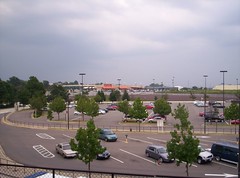An interesting community development corporation constructed project... in San Francisco
 Harvest Urban Market, San Francisco. Photo from the San Francisco Chronicle.
Harvest Urban Market, San Francisco. Photo from the San Francisco Chronicle.To further explain my point in the previous entry about DC's publicly-funded community development activity not accomplishing all that much, last year, I wrote an entry entitled "Falling up -- Accountability and DC Community Development Corporations" about how the Post writes articles about ineffectual activity, yet the organizations continue to win funding from the DC Government and foundations, and "awards" from the traditional land development organizations. (This follow up entry, "Reader comment on perceptions of quality (reprinted from last August)" is also relevant.)
In "Falling Up," I countered with a mention of a project in SF with retail on the ground floor--in appropriately designed spaces, a lot of the retail spaces constructed by CDCs in DC contravene normal retail space design practices--and 100% affordable housing above.
For more information, see an article by John King about "A SOMA complex with a coffee shop and lively mural proves that affordable housing doesn't have to be ugly housing." This mixed-use affordable housing complex has a grocery store and a cafe on the ground floor--on the street.
Note: I still think they could open up to the street better. The grocery store that failed on H Street, part of the complex of buildings constructed by the H Street CDC, was perpendicular to the street, and this likely contributed to its lack of success.
Also see this story about the Harvest Urban Market, and this page from the architect's website about the SOMA project (great photos).
I think it will be a cold day in hell before we see the typical DC-based CDC or religious-institution-related housing development doing a project at the level of quality of the project in San Francisco. WRT DC-based religious institutions, a case in point is the proposed project in Eckington, and the incendiary roiling of the waters by local religious officials. See "Tensions Boil Over Affordable Housing" from the Washington Post. Not to mention Sursum Corda or the slew of housing along 7th Street NW between N and Rhode Island Avenue NW, which is a classic example, in the negative, of the value of design to building value in housing and financial appreciation of property.
Or how about a local CDC taking the lead in conceptualizing and creating a solid transit-oriented development, especially in an area that could use the boost, like Deanwood, Minnesota Avenue, or Anacostia.
Note that proposals to put an office building (even if it is to move WMATA) at the Anacostia or Minnesota Avenue Metro Stations don't cut it (it's too late probably to do anything with the project at Minnesota Avenue...). See Office buildings won't "save" Anacostia from last August. Mixed-use, adding housing, adding affordable housing, is the way to go.
And speaking of incredibly missed opportunities to do this in the City of Washington, exhibit number one is the Brentwood Shopping Center. "Steps" from the subway in the argot of a real estate salesperson, the "air rights" here could have been far better developed instead of not developed at all.
 Brentwood Shopping Center "steps" from the Rhode Island Metro. This project was built on land sold by the city at an extremely good rate to the developer. Few if any covenants were put on the sale of the land. As I say "when you ask for nothing, that's what you get. When you ask for the world, you don't get it, but you get a lot more than nothing."
Brentwood Shopping Center "steps" from the Rhode Island Metro. This project was built on land sold by the city at an extremely good rate to the developer. Few if any covenants were put on the sale of the land. As I say "when you ask for nothing, that's what you get. When you ask for the world, you don't get it, but you get a lot more than nothing." Publix Supermarket at Douglas Grand, Coral Gables. Housing above. Photo from Urban Planet. See "More People Calling the Mall Home," from the Miami Herald.
Publix Supermarket at Douglas Grand, Coral Gables. Housing above. Photo from Urban Planet. See "More People Calling the Mall Home," from the Miami Herald.Index Keywords: urban-revitalization



0 Comments:
Post a Comment
<< Home